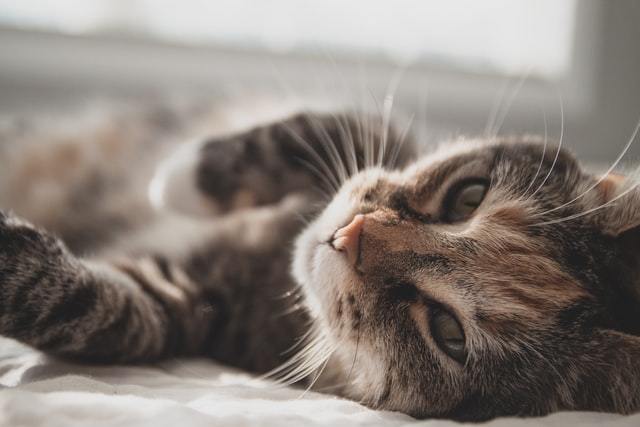Osteoarthritis is a fairly common degenerative joint condition in cats, especially among those felines which are a bit long in the fang (a polite way for saying old).
In a recent study it was found that over 90% of cats over age 12 have evidence of joint disease, so if you know a venerable cat, chances are they’re going to have some level of joint pain.
Despite how common osteoarthritis is, it’s still often under-diagnosed and misunderstood. In this article, we’ll look at osteoarthritis—what it is, how it’s treated and most importantly, how to prevent its symptoms.

WHAT IS OSTEOARTHRITIS?
Osteoarthritis is a degenerative condition, which is just another way of saying it will gradually get worse over time.
Normal joints are protected by soft, squishy tissue called cartilage. When osteoarthritis takes hold, this cartilage breaks down, eventually reaching the point where bones are rubbing against each other and bone spurs form.
Probably no surprises here, but this can cause a lot of pain and reduces limb mobility.
All up, it’s pretty nasty stuff and makes for a grumpy, stressed out cat.
THREE BARRIERS TO PREVENTING THIS CONDITION
So, the obvious next question is, what can I do to prevent osteoarthritis in my cat?
Unfortunately, veterinary science is up against three hefty barriers to preventing this disease.
1. It’s kind of an inevitable part of aging
Firstly, it’s just natural part of aging. Just like with humans, we can slow down the destructive process of aging but we can’t stop it.
2. Cats are sneaky

Secondly, it’s really hard to diagnose in cats. Why? Because the little snickerdoodles are so good at hiding pain. Unlike dogs and humans, cats will deliberately mask their symptoms and compensate for reduced limb mobility.
You might only notice a problem when your cat starts to lose weight, becomes depressed and begins to let their grooming slip.
3. Cats don’t like to be handled

Thirdly, you may have noticed this but cats don’t like to be messed with.
It’s therefore hard for a vet to know during a physical evaluation if a cat’s pulling away means “ouch that hurts” or if your independent-minded companion is simply saying “you smell weird. Go away, you’re annoying me.”
All these factors make osteoarthritis hard to diagnose and therefore hard to prevent in cats.

IT’S ALSO HARD TO TREAT
Adding cattish insult to feline injury, finding pharmacological pain relief that works and isn’t dangerous is hard.
Steroids have been prescribed for osteoarthritis in the past, but they’ve fallen out of favor owing to some pretty nasty side effects.
NSAIDs can also be used and research suggests they can be very effective. However, these too come with a set of difficult side effects and require close management.
You’ll need to discuss analgesic options with your vet to determine if they’re going to be a good treatment option.
Oh and an important warning here. Never use human pain relief drugs on cats. They can be deadly.

SO, IT BOILS DOWN TO MANAGING SYMPTOMS
Given that it’s inevitable, hard to diagnose and difficult to treat, the best thing you can do is focus on managing symptoms and preventing them from having too much of an effect on your fluffer’s life.
Manage your cat’s weight
First, you need to make sure your cat isn’t carrying too much weight. Weight will place additional burden on the whole body, and especially the joints.
Talk to your vet about coming up with a gentle weight-loss eating plan.
Try to make their life a tad easier
You can also help by making life easier for them. Make sure litter trays are easily accessible and while you’re at it, place their food and water in an easy to reach location.
Install cat-friendly ramps
Cats dig hang out spots. It’s just a big part of their life to find some cool little nook and just lay low for a while. It makes them happy.
A big thing you can do for your cat is make those hiding spots a bit easier to access, with strategically placed ramps and platforms.
Encourage gentle exercise
Finally, gentle exercise designed to strengthen muscles around the joints can be effective. However, you don’t want to place too much strain on those sore joints, so it’s best that you design appropriate activities in consultation with your vet.
Use joint supporting nutrients
Finally, you can support your cats joints with a wide variety of joint supporting ingredients (which help rebuild the cartilage and muscles in your cats joints). One of which is the Scruffy Paws Hip n Joint Vitalize Drops, which have been designed to help protect, relieve and rejuvenate your cats joints.
They contain 4 of the most effective, scientifically backed joint support ingredients into 1. When taken regularly the formulation can help reduce pain, swelling and stiffness. Support joint flexibility and mobility, and can help maintain healthy cartilage and connective tissue.
"An eighteen year old with little back leg muscle walked hesitating with each step until she willing lapped up her new med. Today , she walks in the grass , hops from chair to chair and smiles alot"
- Mary G
"Our cat Pinkie has suffered from hip problems for a couple of years. This product has her acting like a young kitten, very active and playful. Great product!!!!!"
- David J
Osteoarthritis can put quite a dampener on your cat’s quality of life. It hurts and it gets in the way of many of the things they love doing.
The good news though is that some effective treatments are available, and if you work with your little buddy to make a few lifestyle changes, there’s no reason they can’t continue to enjoy all their usual weird and wonderful cat-hobbies.






